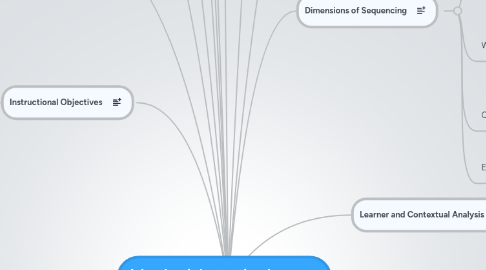
1. Cognitive Domain
1.1. Revised Bloom's taxnonomy
1.1.1. Creating
1.1.2. Evaluating
1.1.3. Analyzing
1.1.4. Applying
1.1.5. Understanding
1.1.6. Remembering
1.2. Bloom's Taxonomy
1.2.1. Knowledge
1.2.2. Comprehension
1.2.3. Application
1.2.4. Analysis
1.2.5. Synthesis
1.2.6. Evaluation
2. Intro to the ID Process
2.1. Instructional Designer
2.1.1. Instructional Problem
2.2. SME(Subject Matter Expert)
2.3. Evaluator
2.4. Learners
2.5. Methods
2.6. Objectives
2.7. Evaluation
3. Task Analysis
3.1. Content Structures
3.1.1. Facts
3.1.2. Concepts
3.1.3. Rules
3.1.4. Interpersonal Skils
3.1.5. Procedures
3.1.6. Attitudes
3.2. Topic Analysis
3.3. Procedural Analysis
4. Instructional Objectives
4.1. Psychomotor Domain
4.1.1. Dave's Model
4.1.2. Simpson's Model
4.1.3. Harrow's Model
4.2. Affective Domain
4.2.1. Behavioral Learning Theory
4.2.2. Cognitive Dissonance Theory
4.2.3. Affective-Cognitive Consistency
4.2.4. Social Judgement Theories
4.2.5. Social Learning Theories
4.2.6. Functional Theories
4.2.7. Krathwohl's Taxonomy
5. Preinstructional Strategies
6. Learning Theory
6.1. Behavioral Learning Theory
6.2. Cognitive Theory
6.3. Social Learning Theory
6.4. Instructional Theory
6.5. Instructional Design Model
6.5.1. ADDIE Design Model
6.5.1.1. Analyze
6.5.1.2. Design
6.5.1.3. Develop
6.5.1.4. Implement
6.5.1.5. Evaluate
7. Cognitive Load Theory
7.1. Intrinsic Load
7.2. Extrinsic Load
7.3. Germane Load
7.4. Goal-Free Effect
7.5. Worked-Example Effect
7.6. Split-Attention Effect
7.7. Redundancy
8. Mayer’s Principles
8.1. Multimedia
8.2. Contiguity
8.3. Coherence
8.4. Modality
8.5. Redundancy
8.6. Personalization
8.7. Voice
8.8. Signaling
8.9. Interactivity
8.10. Pretraining
9. Evaluation Types
9.1. Summative Evaluation
9.2. Formative Evaluation
9.3. Confirmative Evaluation
9.4. Validity
9.5. Reliability
9.6. Relative Standards
9.7. Absolute Standards
10. Planned Change
10.1. Diffusion
10.2. Adoption
10.3. Innovation
10.4. CLER Model
10.5. CBAM
11. Project Management
11.1. Scope
11.2. Project Agreement
11.3. Legal Considerations
12. Types of Needs and Data Sources
12.1. Normative Needs
12.2. Comparative Needs
12.3. Felt Needs
12.4. Expressed Needs
12.5. Future Needs
12.6. Critical Incident Needs
13. Needs Assessment Process
13.1. Phase 1: Planning
13.2. Phase 2: Collecting Data
13.3. Phase 3: Data Analysis
13.4. Phase 4: Final Report
14. Goal Analysis Process
14.1. Identify an Aim
14.2. Set Goals
14.3. Refine Goals
14.4. Rank Goals
14.5. Refine Goals Again
14.6. Make a Final Ranking
14.7. Performance Assessment
15. Learner and Contextual Analysis
15.1. Contextual Levels
15.1.1. Learner Factors
15.1.2. Immediate Environment Factors
15.1.3. Organizational Factors
15.2. Contextual Analysis
15.2.1. Orienting Context
15.2.1.1. Learner Goals
15.2.1.2. Perceived Utility
15.2.1.3. Perceptions of Accountability
15.2.2. Instructional Context
15.2.3. Transfer Context
16. Dimensions of Sequencing
16.1. Learning Related Sequencing
16.1.1. 5 Student Learning Concepts
16.1.1.1. Identifiable Prerequisites
16.1.1.2. Teaching the familiar
16.1.1.3. Difficulty
16.1.1.4. Sequencing Based on Interest
16.1.1.5. Sequencing Based on Development Theory
16.2. World Related Sequencing
16.2.1. Physical Attributes
16.2.2. Spatial Relations
16.2.3. Temporal Relations
16.3. Concept-Related Sequencing
16.4. Elaboration Theory Sequencing
16.4.1. Content Expertise Sequencing
16.4.2. Task Experience Sequencing
17. Generative Strategies
17.1. Recall
17.2. Integration
17.3. Organizational
17.4. Elaboration
18. Gagne Resources
18.1. Conditions of Learning
18.1.1. Present the knowledge
18.1.2. Give practice with feedback
18.1.3. Give guidance
18.2. Nine Events of Instruction
18.2.1. Gain Attention
18.2.2. Describe The Goal
18.2.3. Stimulate recall of prior knowledge
18.2.4. Present the material to be learned
18.2.5. Provide guidance for learning
18.2.6. Practice
18.2.7. Give Feedback
18.2.8. Assess performance test
18.2.9. Enhance Retention
